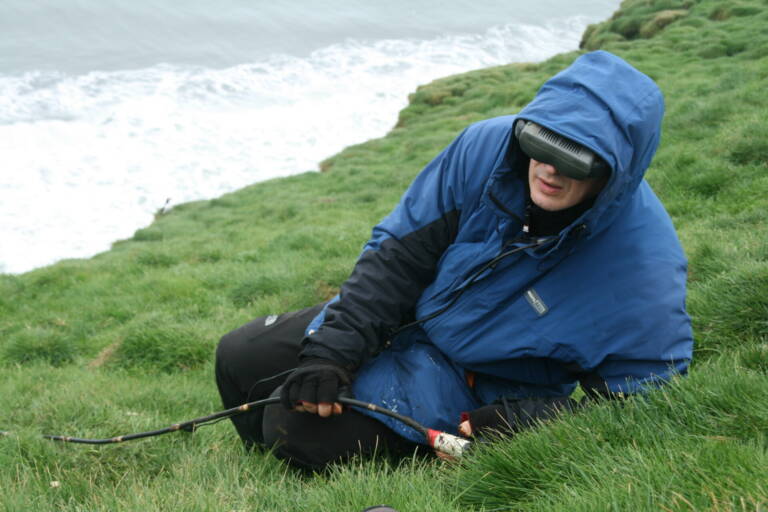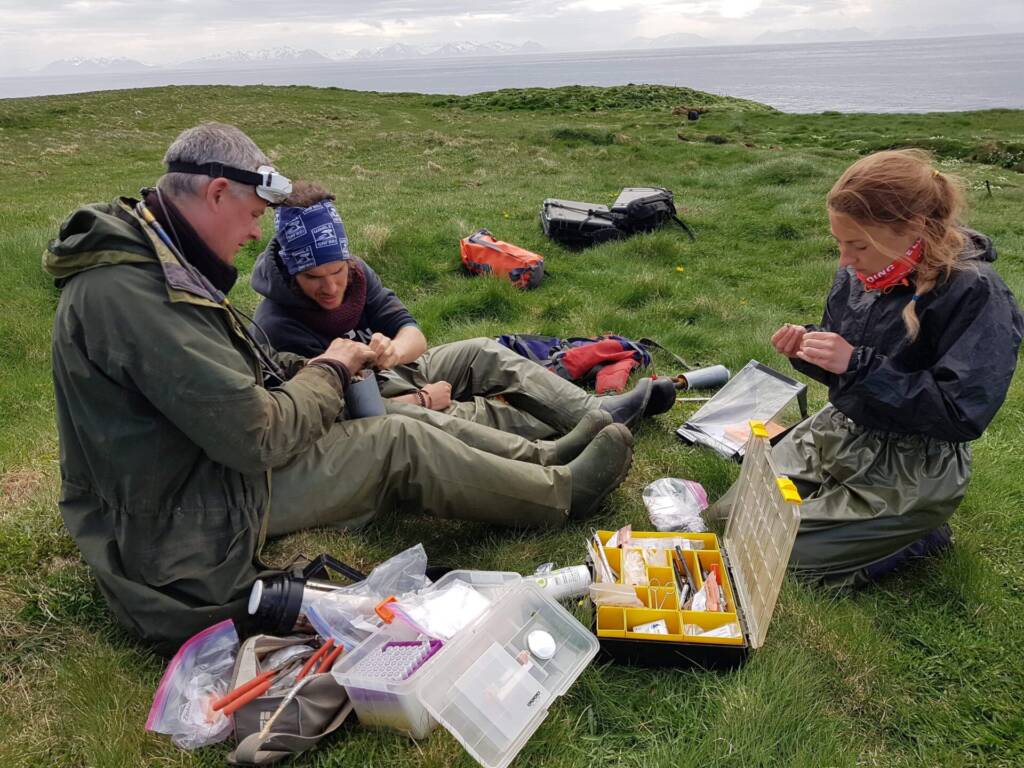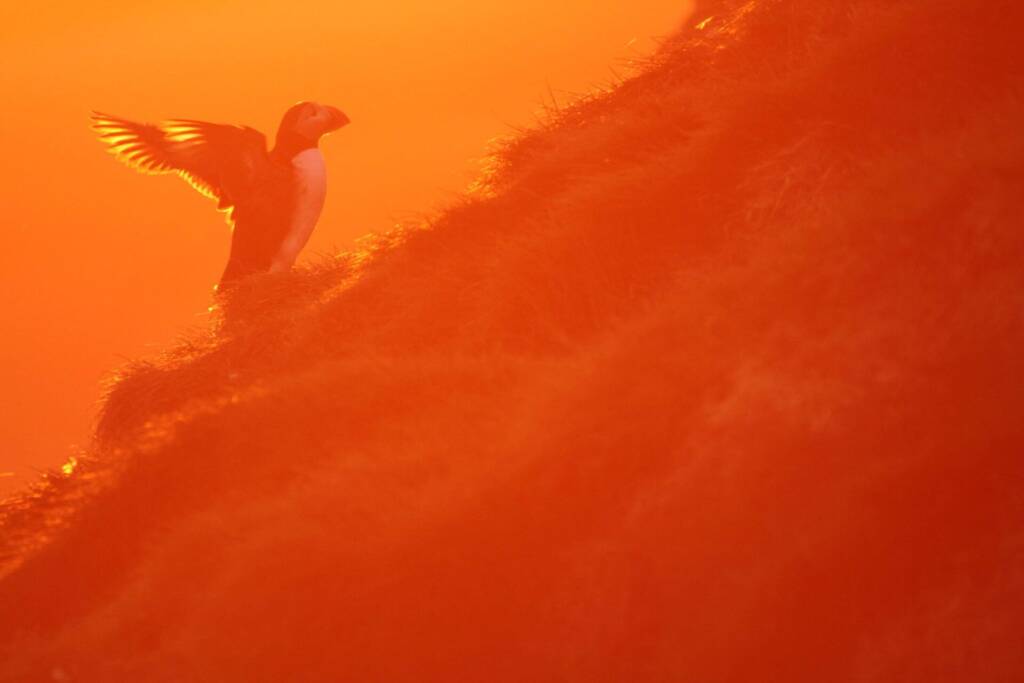Erpur Snær and Tóti Lund have in common that they are experts in puffin ecology, but from undeniably different perspectives.
Name: Erpur Snær Hansen
Age: 58
Occupation: Director of the South Iceland Nature Institute
Your favorite place in Iceland: Vestmannaeyjar
Who does the cooking in your home? Me, because it’s one of my main hobbies and works well for taking a break from science.
What did you want to be when you grew up? I decided to become a doctor of biology at age 14, but a brain surgeon as a kid, I was fascinated by the human mind.
What book do you have on your bedside table? None, I really only read science, little reading stamina after that occupation.
What to do this weekend? Finish insulating the ceiling at home.
Do you have pets? Yes, we have two cats.
Coffee or tea? Coffee. One of the best purchases of my life was a good espresso machine that we use a lot.
What is your main form of exercise? Yoga, but I don’t really exercise anymore, probably out of laziness.
What’s the weirdest thing you’ve ever eaten/tasted? I have some experience with strange food, snakes, bugs in candy form, etc.
Summer, winter, spring or autumn? Summer.

Do you have a favorite spring bird? No, they come one after another and delight the heart, except for the tent and the girl, who are unbearable hormone-filled noisemakers.
What is your favorite swimming pool (or swimming pool) in the country? Seljavalla pool.
If you could go anywhere in the world, where would you go? Heading there, Tasmania 2026.
How do you contribute to a better visitation with the environment? Through research into sustainable fishing and education about Iceland’s amazing nature.
What advice would you give to university students currently studying? Follow your heart, passion is the strongest driving force when endurance begins to wane due to prolonged stress.
What is the connection of your research to South Iceland?
My headquarters are in the Vestmannaeyjar Islands and I do seabird research there. I live in the largest puffin colony in the world on Heimaey, and the islands are also home to three species of nightjars that have long fascinated me with their peculiar ways of life.

Why did you choose this research topic?
Seabirds are interesting in many ways, but they are also the group of birds that has declined the most in numbers globally. This makes it easier to work with them since most of them nest in settlements. Furthermore, they have a common specialization of living on seafood, are really only tied to land to nest, but have an adventurous life outside it, which my generation is lucky enough to be able to study for the first time in history with small electronic devices and other innovations, in fact, it is an ongoing scientific revolution in most senses.
What did you enjoy most about the research work?
I have visited over 13 settlements around the country, twice a summer for 15 years. These expeditions give you an incredibly broad exposure and at the same time respect for the environment you are trying to understand. Discoveries of what factors cause changes in this most common bird in the country, how and why? You also meet many interesting people through this activity.


Briefly tell us about the study and its results.
The main project is the ecology of puffins. What drives and how are changes in population size controlled? This is a long-term project where I am building a multidisciplinary knowledge base to answer interesting questions about the interaction of environment and population change.
The basis for this research was created when we found that about 72% of the variation in puffin population size over the past 140 years is “explained” by ocean temperature and follows the so-called AMO pattern, which alternates between warm and cold periods lasting about 35 years. Temperature has a variety of direct and indirect effects on marine ecosystems, but is also a covariate of other factors. In practice, this can be divided into two, in summer food supply controls juvenile production, and in winter survival.
We have mapped the wintering and migration sites with diurnal records, which was part of a major discovery of the existence of a “hot spot” in the North Atlantic Current where millions of seabirds live in abundance of food, and explains the large population size of these seabird species. Following the warming of 1995, there was a 50% decline in one of the main food species, the nightjar, and has remained so since then. Puffins are flightless for about 45 days in these areas in February-March and cannot escape the food shortage. In summer, we have focused on the sand eel, which is the main food, and its relationship to sea temperature. The population size of puffins decreases by 55% with a 1°C deviation from the mean annual temperature, and the main hypothesis is that during warm periods, the growth of young puffins (which hatch in early spring) slows down during the summer, but increases their metabolism the following winter when accumulated fat reserves are depleted, and that this interaction kills them from starvation before food supply increases in the spring after the first winter.
It is unknown how cold periods affect the population, but in general puffin arrivals are good during cold periods, but bad during warm periods. We have also discovered a large delay (18 days) in the breeding season in the Vestmannaeyjar since 2005, and the later, the fewer birds are breeding. This delay was in addition to the negative effects of warming on arrivals and has not happened before, at least since 1937. Interestingly, the timing of spring algal blooms has been significantly delayed in parallel. We are currently working on two related projects. 1. Calculating the timing of the algal bloom, as well as the spawning and hatching times of stilts (which are temperature-controlled) as far back as available weather data (possibly 1878, but 1949 for the first round) to test the hypothesis that a late spring bloom caused significant losses of stilt larvae, reflected in poor puffin survival due to food shortages.
It is likely that changing wind patterns, increased frequency and strength of southerly winds play a major role (breaking up thermal stratification in the ocean in spring, which is a prerequisite for the bloom), and possibly to some extent a 25% decrease in silica concentration (which limits the growth of diatoms, which in turn marks the beginning of the spring bloom). 2. A study of what controls birds’ failure to nest, which is very common among all seabird species, but management is largely unknown. We have monitored nesting in over a thousand nesting holes for 15 years and it is seen that a major influencing factor is the nesting success of the previous year, if the nesting fails then there is a high probability that the nest will be abandoned the following year and vice versa. In the Vestmannaeyjar, the majority of nesting birds have abandoned nests after bad years in the previous year and this explains the largest part of the decrease in arrivals (chick/hole), and in excess of nesting success. We have different marine ecosystems around the country which is reflected in the different frequencies of this nesting failure.


